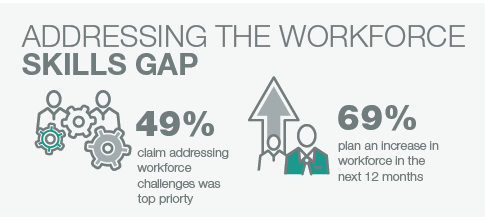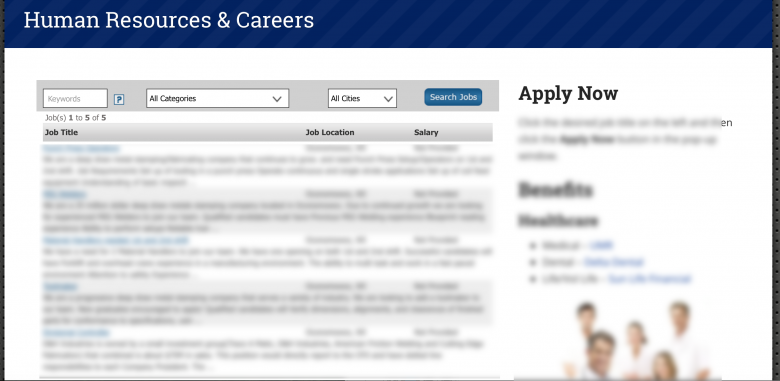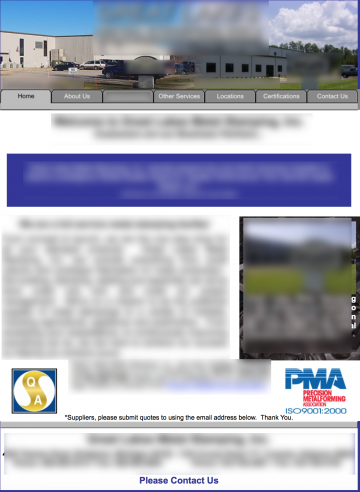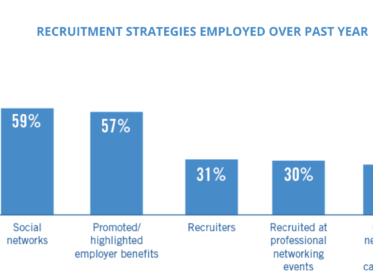A recently released report by consultants Sikich Manufacturing confirms what we already know: lack of qualified workers in industrial manufacturing is a growing problem. Specifically, a full 60 percent of companies reported that lack of qualified workers is a barrier to their business growth – up from 51 percent last year.
This number is even more concerning given that 69 percent of the respondents plan to increase headcount next year. (Figure 1)

In short, manufacturers need skilled labor — but skilled labor is in short supply.
While some initiatives have been put in place to address the skilled labor shortage, there’s one overlooked opportunity no one is talking about.
And that opportunity is your manufacturing website.
We’ve written on this topic before, but it’s worth elaborating here. There’s a lot you can do to attract skilled labor with your website (or, rather, a lot you can do to not discourage potential job applicants) – but few small manufacturers are doing these things.
Therefore, let me outline five practical ways you can use your website to attract skilled job applicants:
1. Add a Careers section
Adding a Careers section to your website lets interested parties know (1) you’re hiring, (2) for which positions you’re hiring, and (3) you’re serious about attracting outside applicants.
Having a Careers section is especially important if you advertise open positions on job sites, such as Monster.com or Indeed.com. If applicants find your listings on these sites, you can be sure they’ll visit your website for more information. If they can’t find a detailed job listing, they’ll be dissuaded from applying.
An example of a Careers page is Figure 2 from a small manufacturer’s website. This page lists all of the open positions. When a job seeker clicks on any job, a new page opens to the full job description.

Once you have your Careers page in place, make sure it’s highly visible on your website. Don’t hide it into a submenu! You want to catch the attention of people who come to your website, whether they’re looking for a job or not. Even if they’re not looking, they may know someone who is.
For example, this website has a “Careers” button as part of the main page navigation, making it almost impossible to miss:

2. Update your website’s design
Unfortunately, a Careers section will have limited value if it’s located on a tired, out-of-date website.
The value of a good, well-designed website is hard to explain. Good design goes beyond something that looks flashy. A well-designed website incorporates all kinds of things that most owners or marketing teams of small manufacturing firms simply don’t think about (and nor should you, because truthfully, your job is to create more product efficiently, not know all the ins and outs of website design and coding).
Suffice to say, what you should know is that a well-designed website – one that’s been created around YOUR business – sends the message to potential job applicants that you’re modern, innovative, and that you’re a great employer.
Communicating that you’re modern and innovative is especially important when you’re trying to attract younger applicants. People in their 20s and 30s are accustomed to a certain level of visual appeal and functionality in technology, including the websites of their employers.
In contrast, a website with an outdated, clunky design says: “We’re old. We’re stuck in old ways of doing things. We’re not innovative” – even if the exact opposite is true.
Figure 3, for example, shows the home page from the type of clunky, outdated manufacturing websites we see just about every day. Even with the blurred out copy, you can see the template is vertical versus horizontal (and thus not mobile-friendly) and the photo is of the building rather than people.
Why would a Gen Z or Millennial want to work here? This company might be an excellent place to work, but you wouldn’t guess that from the website. Oy!

3. Make your website mobile friendly
Having a mobile-friendly website has gone well beyond “nice to have” to a MUST-HAVE if you want to attract highly-skilled, younger job applicants.
Case in point: While in the gym locker room recently, we overhead a young woman venting her frustration that she could not submit a job application via her mobile device. She was stuck at the gym for her shift – and had told a prospective employer she would get her application in. The problem was, the online form she had to submit wasn’t mobile friendly. Argh! She was beyond frustrated.
We work with a client who is in the middle of a huge recruitment process. The client tested an integrated HR / payroll system – which included an online job application.
The big corporate HR / payroll system seemed like it met all the requirements and had a slick sales pitch and reputable clients — but didn’t meet our client’s needs.
In fact, the entire system was a complete disaster. When we tested the form on our mobile devices, none of here in the office could get past the first screen. When we contacted the HR company’s developers, we were told that applicants needed to fill out the form on their desktop computers.
We were a bit taken aback. This is 2017 – not 2008. Not everyone has a desktop, and second, the form should be mobile-friendly.
But, we wanted to make this work for our client, so we made alterations to the landing page. Unfortunately, the form was so difficult to use that job applications went from 15+ per week to zero.
The client had no choice but to terminate the trial run.
4. Consider apprenticeships
In June, President Trump signed the Executive Order that expands apprenticeships in America. The Department of Labor has now revamped its own website to promote this wonderful program.
If you’re a small manufacturer, hiring someone through this program is a great way to train kids just out of high school or a technical program – while helping them gain valuable experience.
See the Department of Labor’s website for additional details – and once you have your program in place, announce it on your website!

5. Get ahead of the hiring competition
We love working with small manufacturers and seeing all the wonderful things they’re doing – but the fact is, the bar is set pretty low when it comes to attracting skilled hires through the company website.
If you want the best employees, then you have to show you’re the best – and it starts with the first impression of your company website.




